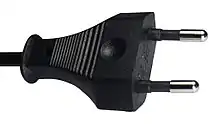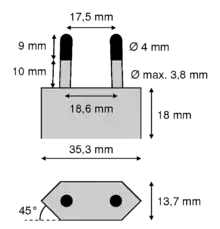Europlug
The Europlug is a flat, two-pole, round-pin domestic AC power plug, rated for voltages up to 250 V and currents up to 2.5 A.[1] It is a compromise design intended to connect low-power Class II appliances safely to the many different forms of round-pin domestic power socket used across Europe. However, it is not compatible with the rectangular-pin BS 1363 sockets found in Cyprus, Gibraltar, Ireland, Malta and the United Kingdom. Europlugs are non-rewirable and must be supplied attached to a power cord.

History
The Europlug design, intended for use with socket-outlets meeting other standards, appeared first in 1963 as Alternative II of Standard Sheet XVI in the second edition of CEE Publication 7 by the contributing members of Austria, Belgium, Czechoslovakia, Denmark, Federal Republic of Germany, Finland, France, Greece, Hungary, Italy, Netherlands, Norway, Poland, Portugal, Sweden, Switzerland, United Kingdom, and Yugoslavia.[2] The Europlug is therefore sometimes also referred to as the "CEE 7/16 Alternative II plug" or simply as the "CEE 7/16 plug". It was also described in 1975 as plug C5 in IEC Technical Report 83. In 1990 it was defined by Cenelec standard EN 50075[1] which has national equivalents in most European countries, as described in IEC 60083[3] which superseded IEC/TR 83 (and no longer uses the C5 designation).
The Europlug is unusual as the standard specifies only a plug; there is no socket-outlet designed specifically for use with it.
Design considerations
The dimensions of the Europlug were chosen for compatibility and safe use, such that with continental European domestic power sockets.
- reliable contact is established when the plug is fully inserted;
- no live conductive parts are accessible while the plug is inserted into each type of socket;
- it is not possible to establish a connection between one pin and a live socket contact while the other pin is accessible.
Additionally, the design allows for a more compact and less bulky design of mobile phone chargers, than the BS 1363 form factor in the UK.
Europlugs are only designed for low-power (less than 2.5 A) Class II (double-insulated) devices that operate at normal room temperature and do not require a protective-earth connection.
Details

The pins of the Europlug are 19 mm long. They consist of a 9 mm long conductive tip of 4 mm diameter with a rounded ending, followed by a 10 mm long flexible insulated shaft of not more than 3.8 mm diameter. The two pins are not exactly parallel and converge slightly; their centres are 17.5 mm apart at the tip and 18.6 mm apart at the base. The elasticity of the converging pins provides sufficient contact force for the Europlug's current rating with a variety of socket-hole arrangements. The entire plug is 35.3 mm wide and 13.7 mm high, and must not exceed these dimensions within 18 mm behind its front plane (this allows for the recesses on many European socket types). The left and right side of the plug are formed by surfaces that are at 45° relative to the horizontal plane.[1]
Compatibility
Type D
The Europlug is not compatible with type D sockets, used in e.g. India and South Africa. These sockets have 5.1 mm holes with centres spaced 19.1 mm apart, which means a Europlug can be inserted if the sockets do not have protective shutters. However, the socket design might not allow the plug to grip it.
Types C, E, F, and K
The Europlug is designed to be compatible with these sockets. They have 4.8 mm holes with centres spaced 19 mm apart. The minimum distance between the holes is thus 14.2 mm, while the minimum distance between the converged pins on the Europlug is 13.5 mm, allowing it to grip the socket despite its smaller pin width.
Type G
The Europlug is physically not compatible with BS 1363 13 A sockets, used in e.g. the UK and Ireland. UK law requires a suitable fuse to be fitted in each plug to protect the appliance flexible cord; Europlugs do not contain such fuses. BS 1363 sockets contain a child-safety shutter; clause 13.7.2 of BS 1363-2 requires that Europlugs will not open the shutters.[4] In some types of BS 1363 socket (but not all) the safety mechanism can be tampered with so that a Europlug may then be forced into the open line and neutral ports. The UK Electrical Safety Council has drawn attention to the fire risk associated with forcing Europlugs into BS 1363 sockets.[5] There is also a risk of damage to both the plug and socket.
UK Consumer Protection legislation requires that most domestic electrical goods sold must be provided with fitted plugs to BS 1363-1.[6] The exception is that shavers, electric toothbrushes and similar personal hygiene products may be supplied with a Europlug as an alternative to the BS 4573 plug (see below).
Fused conversion plugs to BS 1363-5 are available for Europlugs, and equipment fitted with these may be legally sold in the UK.[7]
Types H and N
These sockets are designed to be compatible with the Europlug. They have 4.5 mm holes with centres spaced 19 mm apart. The minimum distance between the holes is thus 14.5 mm, while the minimum distance between the converged pins on the Europlug is 13.5 mm, allowing it to grip the socket despite its smaller pin width.
The 10 A variant of type N used in Brazil has 4.0 mm holes and also allows the Europlug to be used; see Types J and L.
The 20 A variant of type N used in Brazil has 4.8 mm holes and also allows the Europlug to be used; see Types E, F and K.
Type L
The Europlug is designed to be compatible with Type L sockets. They have 4.0 mm holes with centres spaced 19 mm apart.
SN 441011 (Switzerland), Type J
The Europlug is designed to be compatible with Type 11 & 12 (outdated single-phase sockets, 10 A) and Type 13 (recessed single-phase socket, 10 A; Type J) and is consequently compatible with all by SN 441011 currently supported sockets.[2] This includes Type 15 (single-phase, 16 A), Type 21 & 23 (three-phase, 10 A) and Type 25 (three-phase, 16 A). The diameter of the openings of the 10 A sockets is 4.5 mm and the openings of the 16 A sockets are 4.5 x 5.5 mm wide. The norm space between L (one-phase) or L1 (three-phase) and N is 19 mm.
BS 4573 (UK shaver)
The Europlug is not designed to be compatible with BS 4573 sockets. These sockets have 5.1 mm holes with centres spaced 16.7 mm apart, meaning a reliable contact might not be possible.
Most 2-pin UK shaver sockets will accept either BS 4573 plugs or Europlugs, but are rated for a maximum of 0.2 A. UK Consumer Protection legislation allows for shavers, electric toothbrushes and similar personal hygiene products to be supplied with a Europlug as an alternative to the BS 4573 plug.
See also
| Wikimedia Commons has media related to CEE 7/16. |
- AC power plugs and sockets
- IEC 60906-1 – the international standard for 230 V plugs and sockets
- Schuko – the system of CEE 7/3 sockets and CEE 7/4 plugs
References
- European Standard EN 50075: Flat non-wirable two-pole plugs, 2.5 A 250 V, with cord, for the connection of class II-equipment for household and similar purposes. CENELEC, Brussels, 1990.
- IECEE CEE-7:1963, Specification for plugs and socket-outlets for domestic and similar purpose (PDF, CD) (commercial PDF download or CD) (in French and English) (2.0 ed.). Geneva, Switzerland: CEE. 30 April 1963. ISBN 2-8318-1032-0 Check
|isbn=value: checksum (help). Retrieved 2020-12-14 – via IEC Webstore. - IEC/TR 60083: Plugs and socket-outlets for domestic and similar general use standardized in member countries of IEC (PDF, CD) (commercial PDF download or CD) (in French and English) (6.0 ed.). Geneva, Switzerland: IEC. 23 February 2009. Retrieved 2020-12-14 – via IEC Webstore.
- Extract from BS 1363-2:2012: Specification for 13 A switched and unswitched socket-outlets, May 2012. It shall not be possible to operate a shutter by inserting a 2-pin plug into a 3-pin socket-outlet. Compliance shall be checked by the tests of 13.7.2. 13.7.2 Earth pin operated shutters and 3-pin operated shutters shall be deemed to comply with this requirement without testing. For other shutter designs, compliance shall be checked by the following test. A 2-pin plug complying with BS EN 50075 shall be applied to the socket line and neutral apertures with a force of 30 newton. The plug pins, when applied in any direction, shall not make contact with live parts.
- "Conversion Plugs for Foreign Appliances", Switched On, Issue 9, Summer 2008, p17
- "The Plugs and Sockets etc. (Safety) Regulations 1994". Opsi.gov.uk. 1994. Retrieved 21 May 2014.
- "United Kingdom: Check power plugs and outlets | World-Power-Plugs.com". world-power-plugs.com. Retrieved 2019-05-30.